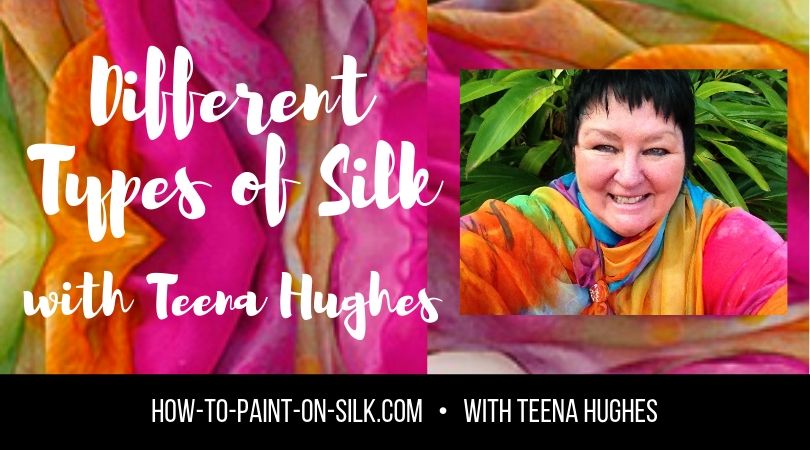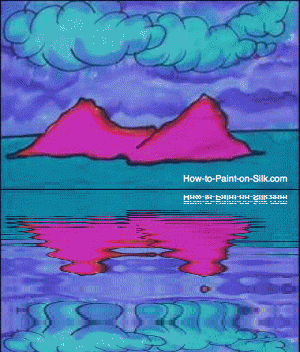Talking about Different Types of Silk for Silk Painting
Hi, this is Teena Hughes. In this video I want to talk to you about different types of silk. Now rather than show you white silk, it’s a bit hard to see on a video like this – so I’m going to show you some silk that I’ve already painted.
Now this one, bright and shiny slippery to the touch is Habotai
Habotai is the main silk that you use when you’re learning to paint on silk because the dyes flow so beautifully.

Now I don’t know if you can see these designs here, but I’ve actually used a wax technique on this. This one’s quite old – it’s about 10 years old and you can see that the Wax has masked off certain areas, but it will continue to feel luxurious. Now if you’re using silk dyes, which is what this course is all about, the silk will always feel beautiful.
You will not feel any dye or any product on the silk if you follow my instructions because there’s nothing worse than having a beautiful silk scarf around your neck, and having it feel itchy or scratchy.
Now this next silk is a silk twill.
This one’s interesting and you can actually see the grain. I don’t know if you can see it on the video or not. And I’ve left some parts white and I’ve let the dyes flow. You can see here I’ve left one stripe in white and some other patterns and I didn’t mask this out, I just paint it on the silk twill. Now twill is very good. For example, for men’s shirts, have you ever seen a man wearing a silk shirt in summer? It can look very unattractive because of the perspiration, and that’s only because it’s the wrong type of silk. Silk Twill is perfect for men’s and ladies shirts and clothing, whereas the silk Habotai is great for scarves but not for clothing.
Habotai is perfect for scarves! and cold weather
Now also the Habotai is an extremely tight weave. It’s very hard to see the actual fibers in this. Now being a tight weave, that means it’s perfect for winter climates or whenever you want to have something warm on.
If you put on the silk habitat or scarf in winter, you’ll be toasty. pie-warm. And I know people who actually wear silk clothing in winter in Europe and you don’t need a coat over the top of it because it is so warm and it keeps the warmth in, and keeps the cold out. Whereas the other silks, depending on how open the weave is they’re better for summer climates.
Silk Chiffon is perfect for summer
Now, for example, one of the most perfect silks for summer is silk Chiffon. Now this is a gossamer fine silk Chiffon scarf that I’ve painted in purple and yellow. But the beauty of this is you can see through it.
You can see my hand there and that if I was to gently blow my breath against this silk, I would feel it on the other side. Now that means that this is perfect for summer. Any fabric that you can, put up to your mouth and blow through with your mouth, you can feel your breath on the other side of the silk. That means it’s an open weave and it lets the air flow. So the more open the weave, the better it is. I wear a lot of Silk Chiffon in summertime. I use it over tank tops mostly. I can wear it in the daytime or the nighttime. I can dress it up, dress it down, and it’s absolutely perfect for the tropics and for hot climates.
Heavier Silk Chiffon
Now here’s another silk Chiffon. This one is a heavier silk Chiffon and you can see it’s a crazy colours, but this one is definitely not as fine as the other one. You can still see my hand through it, but nowhere near as much.
So for each type of silk, there are different qualities of silk in that type of silk. So this is a heavier gauge silk Chiffon.
The thickness and weight of each silk
Now, something I didn’t mention with the Habotai, normally we work on eight mommy. Mommy is the thread count for the fabric – and most fabrics have a mommy. If you see that in a magazine or in a catalog or online, it’s written as eight m m. So it looks like millimeters, but it actually means Mommy, which is the weight of that particular silk. Now that’s handy to know because eight mommy is perfect for learning to paint on silk. 12 mommy is heavier, it takes up more dye.
So you need to think about that when you start to paint. If you want to paint a big pieces, the heavier the fabric, the more dye the fabric will absorb. So this Chiffon here, this is actually a knee length dress that has a long slip underneath it, which is just gorgeous.
Now in the same quality of Chiffon is another one in a turquoise and purple, and it’s the same thickness as the one I just showed you. And if you look at this here, I’ve just doubled the fabric. So when it’s doubled, it’s harder to see through. So that’s also something that’s nice when you’re thinking about even making scarves. If the scarf is doubled, gives it extra body and it also means it’s not see-through. So that’s something for you to consider. Here’s another Habotai scarf. This one just has a simple design.
It’s exactly the same silk as this one over here. Shiny, slippery. You can tell that when it’s slippery. And so far all of these silks look the same on either side.
The delicious Sand-washed silk
Now I have another one that I want to show you and it is at the bottom of my bag of tricks. Here it is. Now this one, this one’s fabulous. Oh, it feels so cool compared to the others. Just to touch it with my fingers. This is delicious. Now this is called Sand-washed silk. It’s shiny on one side and it’s matt on the other side so you can wear it either way. Everything I’ve made in it so far I’ve put the shiny on the outside and I just love it. Now it is a thirsty fabric. It does soak up a lot of dye, but the results you get are just beautiful. Now you can see here, this is just all free-hand, I haven’t drawn any designs with Gutta.
Everything I’m showing you is all freehand apart from this one little one over here that had the hearts on it, because to start off with we’re going to do some freehand painting before we get around to using the outliner, which is also known as Gutta and that is spelled G. U. T. T. A.
Okay, so that’s what the silks are about. Now, there are many more types of silk apart from these, but I just wanted to show you a couple of them so you can get an idea for what they’re like. What I recommend we start off with in our course is the Habotai silk because it’s the one that has the most beautiful flow for the dyes. The dyes will just spread gorgeously and there will be not very much work for you to have to do because the dyes will do the work for you, so that’s what we’re looking at.
Wash silk before painting on it with silk dye
Now the one thing I do need to say before I finish this little video is that we need to wash the silk before we paint on it. And you can just wash it either by hand or I now wash my silks on the lingerie cycle in my washing machine. I put the silk into a lingerie bag first — you can buy them for a dollar or $2 in many cheap shops. The lingerie bag, I put a few silk scarves or pieces of silk inside and then I wash it on the gentlest cycle on my machine. Now you never hang the silk out in the sun to dry and never, never, never. But you can just hang it over something inside. You can hang it even on a coat hanger, hang it up in the bathroom, it’ll be dry in a couple of minutes.
Ironing the silk
And when it’s almost touch dry, still slightly down, but almost touch dry, that’s when you can iron it with a, with a reasonably warm iron, hot, warm to hot iron. And that will make it shiny.
So if ever you do wash silk and you leave it too long and it goes a bit crunchy, and when you iron at it, you can see all the wrinkles.you just need to wet it again and then iron it whilst slightly damp and then it’ll get all those wrinkles out. Okay, so that’s it for the types of silk video. I hope you’ve enjoyed this. If you’ve got questions, let me know and we will be looking at more silks as we go on through the course.
Okay, that’s it for this video.
This is Teena Hughes and I’ll be seeing you in the next video.
Bye bye!













